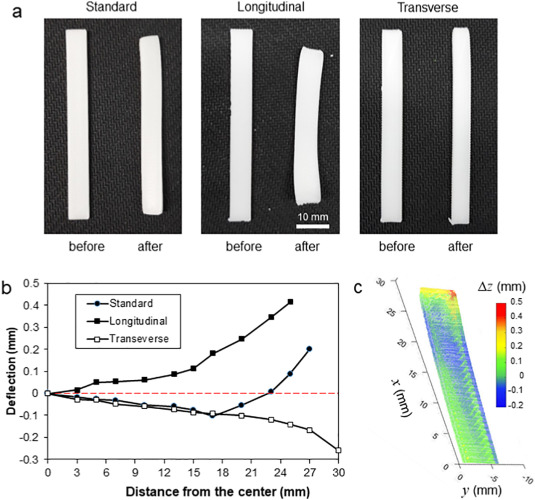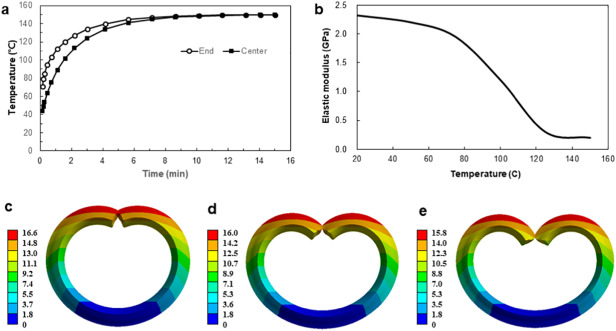In the recently published ‘4D printing using anisotropic thermal deformation of 3D-printed thermoplastic parts,’ researchers Bona Goo, Chae-Hui Hong, Keun Park—all from Seoul National University of Science and Technology—are taking digital fabrication research to the next level. Advancing past 3D printing, the Korean research team experiments with deformation behavior in single thermoplastics.
Most of us are familiar with forays into 4D printing that revolve around shape memory polymers for refinements such as performance and recyclability, combinations with continuous carbon fiber, other 4D innovations for materials like magnetic soft actuators, and much more. For this study, the researchers developed a method employing an ME-type 3D printer and thermoplastic filament—without shape memory—using biodirectional printing paths as layers were printed longitudinally and printed in sequence.
Print paths were programmed for the desired levels of deformation, using ABS to print samples on the ME 3D printer, by Cubicon.
Two different rectangular bars were printed as samples for the study:
“In both cases, eight layers were printed and laminated with a consistent printing path, which is called a homogeneous lamination. In homogeneous lamination, the two printed bars are expected to have different material orientations that may result in anisotropic thermal deformation by an external thermal stimulus,” stated the researchers.
“The anisotropic thermal deformation was then used to realize 4D printing by mixing the transverse and longitudinal printing paths, so-called heterogeneous lamination. For heterogeneous lamination, a rectangular bar (60 × 6 × 1.6 mm) was printed by laminating a number of transversely printed layers (nt) and a number of longitudinally printed layers (nl) consecutively.”
With layer thickness set to 0.2mm and a total of eight layers building 1.6mm, the research team expected a variety of thermal deformations—between transverse and longitudinal areas.

Thermal deformation of the rectangular bars. (a) Photographs of standard, longitudinal and transverse samples before and after heat treatment. (b) Comparison of the vertical deflection along the longitudinal centerline. (c) 3D plot of the vertical deflection (Δz) of the standard sample.
The samples were printed with the following paths:
- Standard 45° and−45°
- Longitudinal 0°
- Transverse 90°
Deformation was compared between samples after each heat treatment performed in the study. Specimens printed longitudinally demonstrated anisotropic deformation yet showed decrease in length and increase in width. The researchers also found that transverse samples exhibited exactly the opposite—caused by variances in residual stress—depending on printing direction.

Directional thermal deformations and the resulting thermal expansion coefficients of homogeneously-printed bars according to printing paths.
The researchers performed further analysis including numerical simulation, which then allowed them to predict what type of deformation would occur in the samples. Further into the study, the research team printed 2D cross and star shapes, thus promoting 2D to 3D deformations.

Results of numerical simulation. (a) Temperature changes of the rectangular bar during heat treatment. (b) Elastic modulus change according to temperature change. Distribution of the vertical displacements with deformed shapes for different transverse-to-longitudinal ratios (unit: mm): (c) nt: nl = 3: 5. (d) nt: nl = 4: 4. (e) nt: nl = 5: 3.

4D printing of a 2D star-shaped specimen. (a) Printing path designs for the star shape. (b) 3D view of the heterogeneous lamination. (c) Shape changes of the star-shaped specimen with an increase in the heating time.
“Considering that the proposed method uses a personal ME printer and a single thermoplastic polymer (ABS) without a shape memory function, this method has advantages in its usefulness and adaptability over other 4D printing methods that use shape memory materials or multiple materials,” concluded the researchers. “The proposed method is also different from conventional 4D printing in terms of its reversibility. That is, the printed parts undergo permanent thermal deformation after appropriate heat treatment while most shape transformations in 4D printing are temporary and reversible.
“These unique characteristics can be utilized in various applications that require permanent deformation after thermal stimulation.”
What do you think of this news? Let us know your thoughts! Join the discussion of this and other 3D printing topics at 3DPrintBoard.com.

4D printing of a heterogeneously printed rectangular bar. (a) Shape changes of the heterogeneous bar with an increase in the heating time (nt = 3, nl = 5). (b) Deformed shapes of the heterogeneous bar after the 15 min heat treatment for different transverse-to-longitudinal ratios.
Subscribe to Our Email Newsletter
Stay up-to-date on all the latest news from the 3D printing industry and receive information and offers from third party vendors.
You May Also Like
Gorilla Sports GE’s First 3D Printed Titanium Cast
How do you help a gorilla with a broken arm? Sounds like the start of a bad joke a zookeeper might tell, but it’s an actual dilemma recently faced by...
Nylon 3D Printed Parts Made More Functional with Coatings & Colors
Parts 3D printed from polyamide (PA, Nylon) 12 using powder bed fusion (PBF) are a mainstay in the additive manufacturing (AM) industry. While post-finishing processes have improved the porosity of...
$25M to Back Sintavia’s Largest Expansion of Metal 3D Printing Capacity Since 2019
Sintavia, the digital manufacturing company specializing in mission-critical parts for strategic sectors, announced a $25 million investment to increase its production capacity, the largest expansion to its operations since 2019....
Velo3D Initiates Public Offering in a Bid to Strengthen Financial Foundations and Drive Future Growth
Velo3D (NYSE: VLD) has been among a number of publicly traded 3D printing firms that have attempted to weather the current macroeconomic climate. After posting a challenging financial report for 2023,...
































